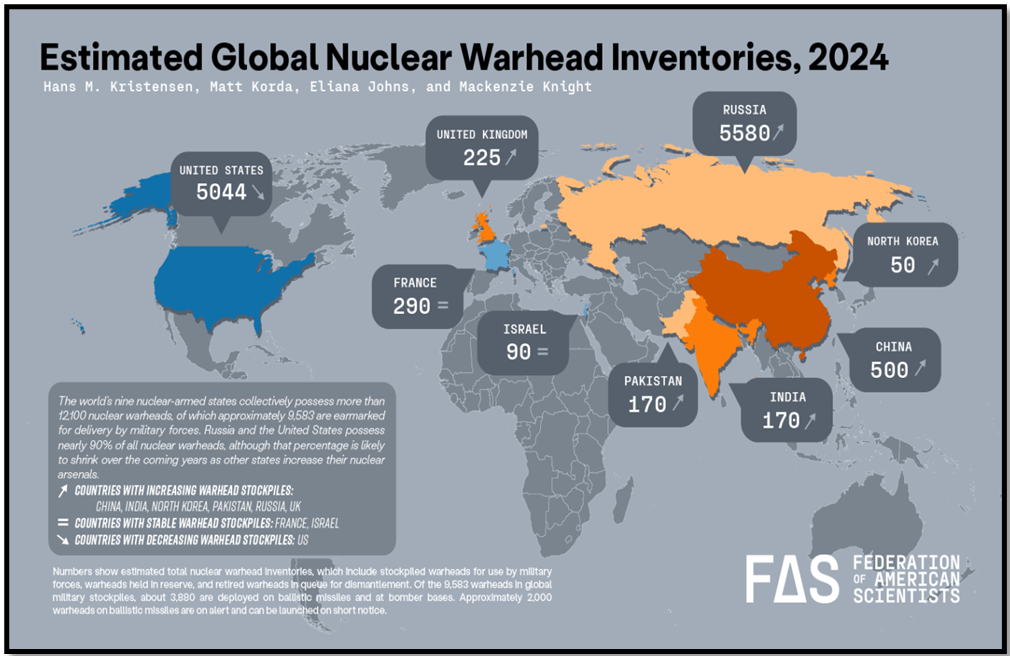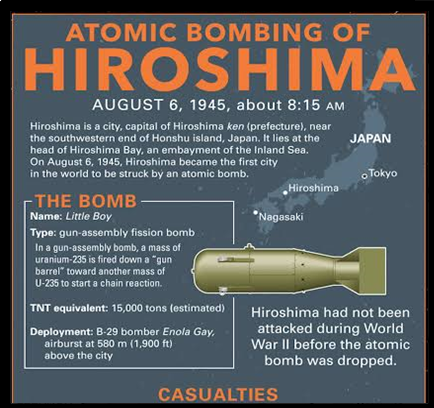RISING TENSIONS: THE LOOMING THREAT OF NUCLEAR WAR
Syllabus:
GS 2:
- India and its Neighbourhood- Relations.
- Effect of Policies and Politics of Developed and Developing Countries on India’s interests
Why in the News?
The article is in focus due to escalating tensions between Israeland Iran, following reports of Israeli strikes inside Iran and concerns over Iran’s nuclear program and potential nuclear weapons
Source: FAS
Israel’s Strikes on Iran
- Context: Following the US withdrawal from the Iran nuclear deal during Donald Trump’s presidency, Iran has breached restrictions on its nuclear activities.
- Uranium Enrichment: Iran is currently enriching uranium to up to 60% purity, which raises concerns about the potential for producing weapons-grade uranium.
Israel’s Response
- Recent Developments: Israel has reportedly carried out a strike within Iran, which may escalate tensions and lead to a broader regional conflict.
- Location: Multiple explosions were reported near a military base in Isfahan, according to Iranian sources. This base is known to house fighter jets and is located in the northwest part of the city.
- Potential Impact: Israel’s actions could increase hostilities in the region and raise questions about the stability and security of the Middle East.
Iran’s Nuclear Capabilities
- Possible Nuclear Bombs: Iran’s ongoing uranium enrichment and nuclear activities suggest that it could produce a nuclear bomb within days or weeks if it chooses to do so.
- Concerns: A senior Iranian Revolutionary Guards commander mentioned that Iran might review its “nuclear doctrine” due to Israeli threats. This raises questions about Iran’s intentions and the peaceful nature of its nuclear program.
Iran’s Nuclear History
- Nuclear Non-Proliferation Treaty (NPT): Iran signed the NPT in 1970 under the rule of the Shah, with plans to expand its nuclear program.
- Changes after 1979: Following the Islamic Revolution and the fall of the Pahlavi dynasty in 1979, Iran’s nuclear program underwent changes and has since been a point of international scrutiny.
Understanding Thermonuclear bombs:
- Thermonuclear bombs, also known as hydrogen bombs or H-bombs, represent a significant evolution from first-generation nuclear weapons such as atomic bombs.
- These second-generation nuclear weapons offer vastly greater destructive power, more efficient use of materials, and potential for compact size and lower mass. Thermonuclear weapons consist of a nuclear fission primary stage that triggers a nuclear fusion secondary stage, creating an enormous explosion.
Historical Context:
- Enrico Fermi first proposed the concept of a thermonuclear bomb in 1941.
- The U.S. conducted the first full-scale test of a thermonuclear bomb in 1952.
- Several other countries, including the Soviet Union, the UK, France, China, and India, developed similar devices.
Indian Thermonuclear Tests:
- India conducted its first thermonuclear test in May 1998, part of the Operation Shakti series.
- The test’s yield remains debated, with claims of a controlled yield of 45 kilotons to minimize local damage and radioactive fallout.
- Indian officials have stated the capability to build thermonuclear weapons of various yields.
Mechanism and Design:
- The primary stage is an implosion-type fission bomb fueled by uranium or plutonium.
- The explosion creates intense heat and thermal X-rays, which flood the space between the primary and secondary stages.
- The secondary stage consists of fusion fuel such as deuterium and tritium, or lithium deuteride.
- The Teller-Ulam configuration chains stages together, allowing for higher yields by providing energy for each subsequent stage.
Impact and Destructive Potential:
- Thermonuclear weapons can yield explosive powers measured in megatons, hundreds or thousands of times more powerful than atomic bombs.
- Explosions produce blast waves, intense light, heat, and radioactive fallout, causing massive destruction and environmental contamination.
- The most powerful bomb ever detonated was the thermonuclear Tsar Bomba from the Soviet Union.
Significance:
- Thermonuclear weapons offer the most efficient design for nuclear weapons with yields above 50 kilotons.
- All five nuclear-weapon states under the Non-Proliferation Treaty use thermonuclear weapons.
- The most powerful bomb ever detonated was the thermonuclear Tsar Bomba from the Soviet Union.
Concerns and Debates:
- Thermonuclear weapons raise strategic, pragmatic, and moral concerns due to their massive destructive power.
- Some scientists argued against their development, while others see them as necessary for national security and deterrence.
- Debates continue regarding the yield of certain tests and the overall risks posed by these weapons.
Understanding Nuclear Bombs:
- Nuclear bombs, also called atomic bombs or nuclear weapons, are powerful devices that release massive amounts of energy through nuclear reactions.
- These reactions manipulate the forces that hold atomic nuclei together, resulting in a significant release of energy.
Basic Principles of Nuclear Bombs:
- Nuclear bombs work based on two primary principles: nuclear fission and nuclear fusion.
Fission-Based Nuclear Bombs (Atomic Bombs):
- Atomic bombs, or fission-based nuclear bombs, use the process of nuclear fission, where an atom’s nucleus is split into smaller parts, releasing energy.
- Key elements in atomic bombs include uranium-235 (U-235) and plutonium-239 (Pu-239).
- A supercritical mass of fissile material is created, enabling a chain reaction where each fission event releases neutrons that trigger further fission reactions.
- Neutrons are introduced to the fissile material to start the fission reactions.
- Fission splits an atom’s nucleus into two smaller nuclei, releasing energy, gamma radiation, and more neutrons.
- The energy released comes as kinetic energy of the fragments, gamma radiation, and kinetic energy of neutrons.
- This energy creates a powerful explosion, producing shockwaves, heat, light, and ionizing radiation.
| Case Study : Hiroshima Bombing
Background:
The bombings effectively ended World War II, leading to Japan’s surrender to the Allies on August 14, 1945. Aftermath:
Japan’s Response:
|
Comparative Analysis
Thermonuclear bombs (H-bombs) utilize a two-stage design combining nuclear fusion and fission reactions, resulting in much higher yields and greater destructive power compared to atomic bombs (A-bombs), which rely solely on nuclear fission reactions.
| Feature | Thermonuclear Bomb (H-Bomb) | Atomic Bomb (A-Bomb) |
| Type of Reaction | Nuclear fusion (combination of isotopes) | Nuclear fission (splitting of an atom) |
| Key Elements | Deuterium, tritium, lithium deuteride | Uranium-235, plutonium-239 |
| Stages | Two stages: fission primary and fusion secondary | Single stage: fission reaction |
| Yield | Measured in megatons (MT) | Measured in kilotons (KT) |
| Destructive Power | Hundreds to thousands of times more powerful | Lower yield compared to H-bomb |
| Size | Can be compact and small | Typically larger size |
| Mechanism | Primary stage triggers fusion in secondary stage | Direct fission chain reaction |
| Effects | Extreme heat, light, blast wave, radioactive fallout | Heat, light, blast wave, radioactive fallout |
| History | First tested in 1952 (USA) | First tested in 1945 (USA) |
| Developing Countries | USA, USSR, UK, France, China, India | USA, USSR, UK, France, China |
| Global Concern | Greater potential for destruction, debated | Considerable concern for global security |
Conclusion:
The escalating tensions between Israel and Iran, particularly in light of Israel’s reported strikes within Iran, highlight the potential for a broader regional conflict with far-reaching consequences. Iran’s continued advancement of its nuclear program and its potential to produce weapons-grade uranium in a short time are cause for international concern. The possibility of nuclear conflict poses significant risks to regional and global security.
Mains Practice Question:
Examine the impact of escalating tensions between Israel and Iran on regional stability and global security. Discuss the role of nuclear non-proliferation treaties in mitigating the risks of nuclear conflict in the Middle East.
Associated Article :
https://universalinstitutions.com/irans-attack-on-israel-signifies-the-end-of-strategic-patience/





